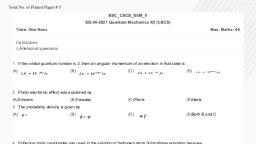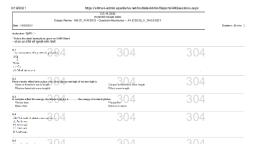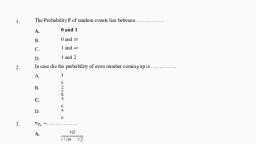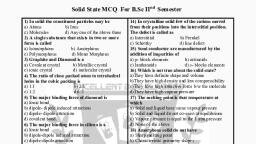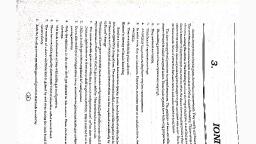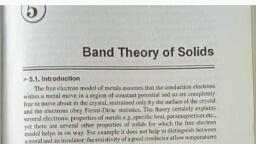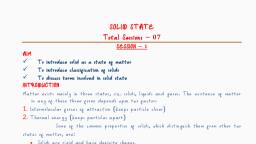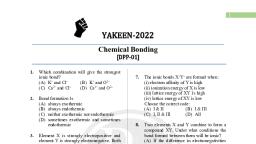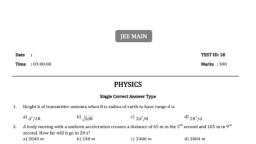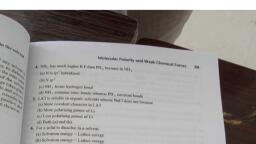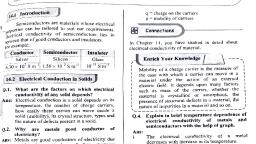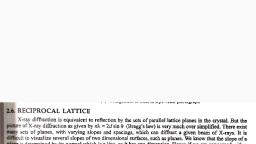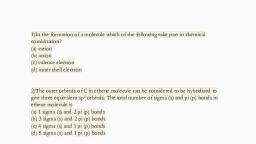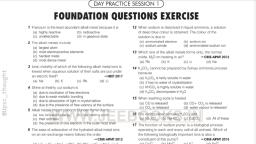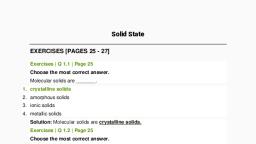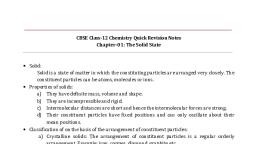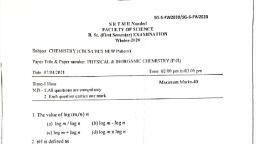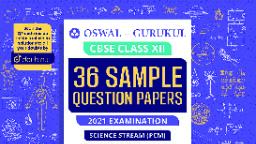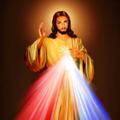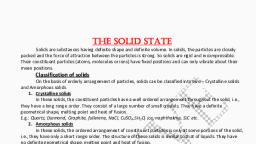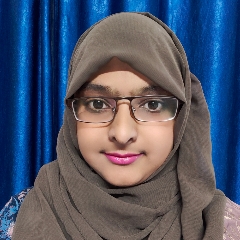Page 1 :
1. If the lattice contains a small group of points, called ……….., A) Pattern unit, B) Single unit, C) Multiple unit, D) None of above, 2. ……………… translation vectors which produce a translation operation containing, integral coefficients are called primitive translation vectors., A) R' = R +1/2 a2 +1/2b2, B) R' = R + T = R+ 0a1 + 1b1, C) R' = R +1/2 a2 +1/2a2, D) R' = R +3/2 a2 +3/2b2, 3. ……………… translation vectors which produce a translation operation containing, non integral coefficients are called primitive translation vectors., A) R' = R +1/2 a2 +1/2b2, B) R' = R + T = R+ 0a1 + 1b1, C) R' = R +1/2 a2 +1/2a2, D) R' = R +3/2 a2 +3/2b2, 4. A unit cell may be defined as the ………….. unit of the lattice which, on continuous, repetition, generates the complete lattice., A) Biggest, B) Single unit, C) Multiple unit, D) Smallest, 5. All the lattice points belonging to a ……….. cell lie at its corners., A) Primitive, B) Non Primitive, C) Single, D) Multiple, 6. All the lattice points belonging to a ……….. cell lie at its corners as will as other, locations., A) Primitive, B) Non Primitive, C) Single, D) Multiple, 7. The smallest volume enclosed by the normal is the required primitive cell. Such a cell, is called ……………, A) Wigner-Seitz cell, B) Unit cell, C) Non Primitive cell, D) Primitive cell
Page 2 :
8. A lattice combined with a basis generates the ………… structure., A) Lattice, B) Crystal, C) Basis, D) All of Above, 9. Crystal structure is mathematically expressed as ………….., A) Lattice + Basis = Crystal structure, B) Lattice + Unit = Crystal structure, C) Basis + Basis = Crystal structure, D) Lattice + Lattice = Crystal structure, 10. Copper is an example of monoatomic ……….. cubic structure., A) Body Centre, B) Hexagonal Closed Pack, C) Face Centre, D) Non of Above, 11. The number of space lattices possible is only …………., A) Ten, B) Fourteen, C) Six, D) Eight, 12. A symmetry operation is that which transforms the ……….to itself., A) Lattice, B) Crystal, C) Basis, D) Non of above, 13. The …………. operation applies to lattices only., A) Reflection, B) Rotation, C) Translation, D) Inversion, 14. The lattice always remains invariant by a rotation of …………, A) 8𝜋, B) 2𝝅
Page 3 :
C) 3𝜋, D) 5𝜋, 15. In rotation symmetry operations minimum rotation of angle is ……°., A) 50, B) 60, C) 70, D) 80, 16. The lattice which divides it into two identical halves which are mirror images of each, other called as …………., A) Rotation, B) Reflection, C) Inversion, D) Translation, 17. Inversion is a point operation which is applicable to ……………..lattices only., A) one-dimensional, B) two-dimensional, C) three-dimensional, D) four-dimensional, 18. The group of rotations, inversion and reflection symmetry operations at a point is called, as ………….., A) Point Group, B) Space Group, C) Single Group, D) Multiple Group, 19. How many different point group operations in two dimensions lattice., A) 20, B) 32, C) 10, D) 12, 20. There are a total of …….. point groups in a three-dimensional lattice., A) 20, B) 32, C) 10, D) 12
Page 4 :
21. Three Dimensional Bravais lattices further become parts ……. distinct crystal systems., A) 10, B) 12, C) 7, D) 5, 22. …………, is defined as the ratio of the volume occupied by the atoms present in a unit, cell to the total volume of the unit cell., A) The packing fraction, B) The Coordination number, C) Unit cell, D) Molecular Space, 23. How many atoms present in body centre cubic structure., A) 4, B) 1, C) 2, D) 8, 24. How many atoms present in Face centre cubic structure., A) 5, B) 4, C) 3, D) 1, 25. Pair of atoms which is capable of forming a stable ………..bond in the solid state., A) Chemical, B) Ionic, C) Physical, D) Covalent, 26. Potential energy of the system may be arbitrarily taken as ……….., A) One, B) Two, C) Zero, D) Three, 27. ………, as in NaCl transfer of valence electrons., A) Ionic bond, B) Covalent bond
Page 5 :
C) Metallic bond, D) Hydrogen bond, 28. …….. bonds are called Primary bonds., A) Ionic, B) Covalent, C) Metallic, D) All of Above, 29. The source of cohesive energy which binds the ions together is mainly, the……………..., A) coulombs electrostatic interaction, B) energy interaction, C) coulombs attraction, D) None of above, 30. ………. Ions cannot continuously approach each other under coulomb attracton on, account of the exclusion principle., A) One, B) Two, C) Four, D) Five, 31. The cohesive energy of the ionic crystals is of the order of ….. to …… eV., A) 5, 20, B) 5,10, C) 8,9, D) 10,20, 32. In ionic crystals have large binding energy and exhibit ………. Melting and boiling, point., A) Low, B) Minimum, C) High, D) Small, 33. A ………….. bond is formed by an equal sharing of electrons between two, neighbouring atoms each having incomplete outermost shell., A) Ionic, B) Covalent
Page 6 :
C) Metallic, D) Hydrogen, 34. The participating atoms attract each other and a ……………..is formed., A) covalent bond, B) Ionic, C) Metallic, D) Hydrogen, 35. The number of covalent bonds an atom can form is determined by …………….., A) 5-N rule, B) 6-N rule, C) 8-N rule, D) None of above, 36. The metallic bond is ……… than ionic or covalent bond., A) Stronger, B) Weeker, C) Very strong, D) None of above, 37. The metallic bonds binding energy ranges from ……. To …… eV., A) 5, 20, B) 1,5, C) 8,9, D) 10,20, 38. The energy released during the formation of van der Waals bond is of the order of ……, eV per bond only., A) 1, B) 0.1, C) 2, D) 0.2, 39. The …………..types of bonding exists in atoms or molecules which have there, outermost shells completely filled and hence have no tendency to gain, lose or share, valence electrons with other atoms or molecules in the solid., A) covalent bond, B) Ionic, C) Metallic
Page 7 :
D) van der Waals, 40. ………… bonds are stronger than van der Waals bonds but weeker than ionic or, covalent bonds., A) covalent, B) Ionic, C) Metallic, D) Hydrogen, 41. ………… is equation of Braggs law., A) 2d sin θ = nƛ, B) 2d sin θ = n, C) d sin θ = nƛ, D) 8d sin θ = nƛ, 42. The ………. Method is mostly used to determine the crystal symmetry., A) Powder diffraction, B) Rotating crystal, C) Laue’s, D) Bragg’s, 43. A Photographic film is attached at the inner ………….surface of the cylinder., A) Circular, B) Rectangular, C) Square, D) Non of above, 44. The symmetry of pattern helps to determine the shape of the ……………, A) unit cell, B) Single cell, C) Multiple cell, D) All of above, 45. ……………….. molecule is produced because of the formation of covalent bonds, between oxygen atom and two hydrogen atoms., A) Sodium Chloride, B) Water, C) Silicon, D) Germanium
Page 8 :
46. The structure of ………… is a good manifestation of the directional properties of, covalent bonds., A) Germanium, B) Silicon, C) Diamond, D) Water, 47. The actual structure of sodium metal is …………., A) Face centre cubic, B) Body centre cubic, C) Simple cubic, D) Hexagonal cubic, 48. The binding energy of water or ice is ……….., A) 0.1 eV, B) 0.5 eV, C) 10 eV, D) 5 eV, 49. The specific heat of substance is defined as the heat required to raise the, ………………of one gram molecule of the substance through 10C, A) Pressure, B) Temperature, C) Heat, D) Volume, 50. According to the first law of thermodynamics, the heat added to a system is used up in, how many ways?, A) Five, B) One, C) Three, D) Two, 51. Which of the correct formula of specific heat of substance., 𝑑𝐹, , A. 𝐶 = 𝑑𝑇, B. 𝐶 =, , 𝑑𝑄, 𝑑𝑆, 𝑑𝑄, , C. 𝐶 = 𝑑𝑉
Page 9 :
D. 𝑪 =, , 𝒅𝑸, 𝒅𝑻, , 52. The first contribution arises from the atomic vibrations and may be called, the………….., A) lattice specific heat, B) lattice specific gas, C) lattice specific temperature, D) Non of above, 53. In general, the specific heat of solid may be expressed as, A) C solid=C lattice + C electric, B) C solid=C vibration + C electric, C) C solid=C rotation +C electric, D) C solid=C inversion +C electric, 54. Crystal consists of atoms which are arranged in a ……………manner and are bound, together by strong binding forces., A) Irregular, B) Periodic, C) Non Periodic, D) All of above, 55. The effect of imparting thermal energy to a solid is to increase the ……………..in the, form of vibrational energy of these harmonic oscillators., A) External energy, B) Atomic energy, C) Internal energy, D) Molecular energy, 56. According to the classical theory, the molar heat capacity of all the solids in constant, and is independent of temperature and frequency this called as ………………, A) Law of kinetic energy, B) Internal energy, C) Dulong and Petit’s Law, D) Non of above, 57. Einstein retained all the assumptions of the classical theory as such except replacing, the ………. oscillators to ……………… oscillators., A) Quantum harmonic, Classical harmonic
Page 11 :
63. The Debye’s continuum model is valid for ………wavelengths only, A) Short, B) Long, C) Small, D) Very Low, 64. The first contribution arises from the atomic vibrations and may be called the, …………., A) lattice specific heat, B) specific heat of solid, C) electric specific heat, D) electric heat of solid, 1, , 65. 2 ђ𝜔 is the temperature independent ……………….. contribution., A) Zero point energy, B) One point energy, C) Two points energy, D) Three points energy, 66. Following is the correct one dimensional wave equation., A), B), C), D), , 𝜕2 𝑢, 𝜕𝑥 2, 𝜕2 𝑢, 𝜕𝑥 2, 𝜕2 𝑢, 𝜕𝑥 2, 𝝏𝟐 𝒖, 𝝏𝒙𝟐, , 1, , 𝜕2 𝑢, , = 𝑉𝑠2 𝜕𝑡𝑥 2, 1 𝜕2 𝑢, , = 𝑉𝑠2 𝜕𝑦 2, , 1 𝜕2 𝑢, , = 𝑉𝑠2 𝜕𝑧 2, 𝟏 𝝏𝟐 𝒖, , = 𝑽𝒔𝟐 𝝏𝒕𝟐, , 67. The Debye’s theory also obeys the ……………….as obeyed by the classical theory, and the Einstein’s theory., A) Dulong and Petit’s Law, B) Debye’s law, C) Specific law, D) None of above, 68. The system expands against a constant pressure, then the first law can be written as., A) dQ = dE + pdV, B) dQ = dE + VdP, C) dq = du + pdV
Page 12 :
D) dQ = ds + pdV, 69. All the oscillators vibrate with the same natural frequency due to the …………….., environment of each., A) Different, B) Identical, C) Both A and B, D) None of above, 70. Any number of oscillators may be present in the same …………state., A) Quantum, B) Classical, C) Both A and B, D) None of above, 71. The wave equation three dimensional case can be written as, A), B), C), D), , ∂2 u, , +, ∂x2, , ∂2 u, ∂y2, 𝛛𝟐 𝐮, 𝛛𝐱 𝟐, ∂2 u, , +, +, , +, ∂x2, , ∂2 u, , ∂2 u, , 1 ∂2 u, , ∂2 u, , 1 ∂2 u, , 𝛛𝟐 𝐮, , 𝟏 𝛛𝟐 𝐮, , + ∂x2 = Vs2 ∂t2, ∂x2, , ∂2 u, , + ∂z2 = Vs2 ∂t2, , ∂y2, 𝛛𝟐 𝐮, 𝛛𝐲𝟐, , + 𝛛𝐳𝟐 = 𝐕𝐬𝟐 𝛛𝐭𝟐, , ∂2 u, , ∂2 u, , 1 ∂2 u, , + ∂z2 = Vs2 ∂t2, ∂yx2, , 72. The total number of vibrational modes are assumed to be ………., A) 2N, B) 3N, C) 4N, D) 1N, 73. The total energy of a conduction electron is equal to its ……………..., A) Potential energy, B) Kinetic energy, C) Binding energy, D) None of above, 74. The electron constituting the electron gas obeys ……………….statistics under, equilibrium condition ., A) Maxwell Boltzmann, B) Bose Einstein, C) Fermi Dirac
Page 13 :
D) All of above, 75. The metal exabits ……………. electrical and thermal conductivity., A) Low, B) Minimum, C) High, D) None of above, 76. The ratio of electrical conductivity and thermal conductivity is called as ……………, A) Widemann law, B) Franz law, C) Widemann-Franz law, D) All of above, 77. The widemann-Franz law can be written as, A), B), C), D), , 𝐾, 𝐾, 1, 𝐾, 𝜎, 1, 𝝈, 𝑲, , = 𝑐𝑜𝑛𝑠𝑡𝑎𝑛𝑡, = 𝑐𝑜𝑛𝑠𝑡𝑎𝑛𝑡, = 𝑐𝑜𝑛𝑠𝑡𝑎𝑛𝑡, = 𝒄𝒐𝒏𝒔𝒕𝒂𝒏𝒕, , 78. Sommerfeld treated a problem quantum mechanically using the ………….. statistics., A) Maxwell Boltzmann, B) Bose Einstein, C) Fermi Dirac, D) All of above, 79. The electron is prevented from leaving the crystal by the presence of a large, ………………barrier at its surfaces., A) Kinetic energy, B) Potential energy, C) Total energy, D) All of above, 80. The potential energy within the crystal or box is assumed to be …………., A) Zero, B) One, C) Two, D) Three, 81. The wave function of the electron occupying the Schrodinger equation., A), , 𝜕2 𝜓, 𝜕𝑥𝑛2, , +, , 2𝑚, ℎ2, , (𝐸𝑛 − 𝑉)𝜓𝑛 = 0
Page 15 :
5, , D) CP=2 𝑁KB, 87. The measurement of …………………coefficient of metals indicates that the number, of electrons per atom in metals is of the order of unity,, A) Optical reflection, B) Electrical reflection, C) Magnetic reflection, D) Magnetic optical reflection, 88. The fermi temperature defined by the equation, A) EF= 2KBTF, B) EF= KB2TF, C) EF= KBTF, D) EF= 3KBTF, 89. If k is Boltzmann constant then k=…….., A), B), , N, R, 𝐑, 𝐍, N, , C) 3 R, , N, , D) 5 R, , 90. The energy passed by an atom or molecule at absolute zero temperature is, ………………, A) ℏω, B) ℏ𝛚/𝟐, C) ℏω/3, D) ℏω/4, 91. The Einstein’s characteristics temperature is given by, A) ℏω, B) ℏ𝛚/𝐤, C) ℏω/3, D) ℏω/R, 92. Thermionic emission of electrons from metal due to at ………….. temperature., A) Low, B) High, C) Both A and B
Page 16 :
D) None of above, 93. Mobile electrons in metal also called as …………., A) Valance electron, B) Conduction electron, C) Binding electron, D) Free electron, 94. The process of emission of electrons from the hot metal surface is called, A) Plastic emission, B) Static emission, C) Thermionic emission, D) Current emission, 95. At room temperature, the electron can not escape metal surface due to, A) Attractive forces of nucleus, B) Repulsive forces of electrons, C) Repulsive forces of nucleus, D) Pulling force of protons, 96. Ohms law can be written as, A) V=IR, B) R=VR, C) R=VI, D) None of above
